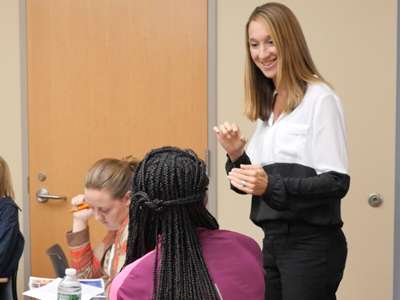Students as teachers effective in STEM subjects

In the traditional college learning structure, students enter the classroom and place their focus on the classroom instructor. But researchers in Syracuse University's College of Arts and Sciences (A&S) biology department are finding that higher levels of academic success may be achieved by adopting an alternative pedagogical model.
Their findings are the subject of a newly published article in the widely-read journal PLOS Biology titled "Peer-Led Team Learning Helps Minority Students Succeed."
The article is co-authored by Julia Snyder, post doctorial research associate; Jeremy Sloane and Ryan Dunk, both biology graduate students; and Jason Wiles, associate professor of biology.
Since 2011, peer-led team learning (PLTL) has been researched at Syracuse University with introductory biology classes functioning as the lab. Through the program, students who have successfully completed the class are invited back the following year to act as peer leaders for incoming students. This cycle of student partnerships has revealed impressive results among the participants, with marked improvements in students' grade performance and course completion in gateway courses, which is critical when trying to retain more students in Science, Technology, Engineering, and Mathematics (STEM) majors.
"Simply put, active learning puts the responsibility for learning on the learners," explains Wiles, who also holds appointments in the departments of science teaching and Earth sciences. "The peer leader is not a teacher nor a tutor. Rather, they are an integral member of the student team with a responsibility for facilitating the group effort toward solving problem sets to which they have not been given the answers."
The recruitment and retention of women and underrepresented minority students into the STEM fields has become a growing priority across many college campuses in the United States. Reflecting on that goal, the researchers hope that the promising results of this multiyear study will encourage the peer-led model to become more widely implemented among first-year students, ultimately broadening participation in STEM fields and diversifying the scientific community.
"There are many challenges to adopting this model in large courses across disciplines, but the data clearly support efforts to overcome obstacles and make it happen here and elsewhere" says Wiles. "We have had great success with PLTL in Biology at SU, and we are looking to expand that success."
More information: Julia J. Snyder et al. Peer-Led Team Learning Helps Minority Students Succeed, PLOS Biology (2016). DOI: 10.1371/journal.pbio.1002398
Journal information: PLoS Biology
Provided by Syracuse University



















